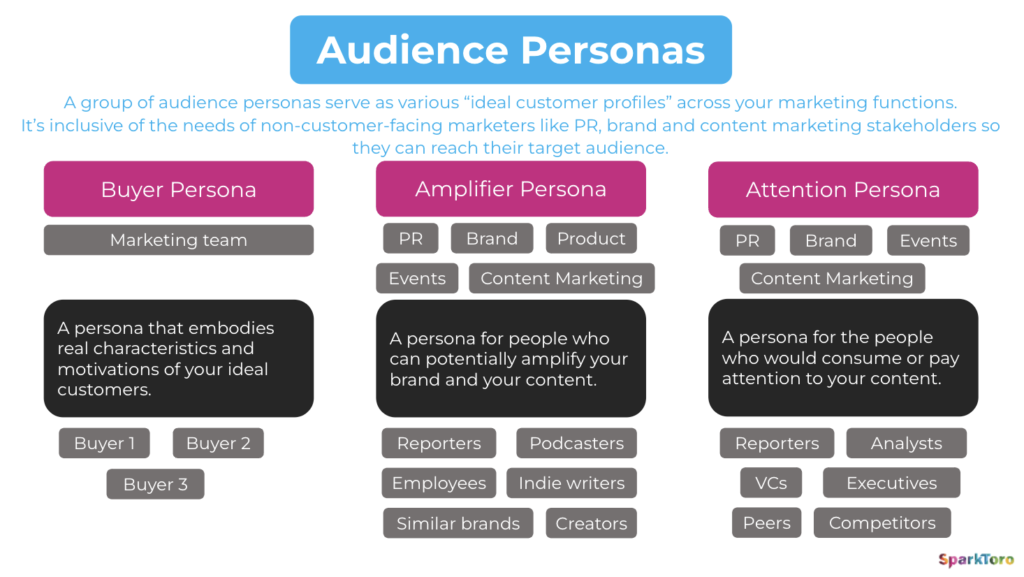A Smart Blog Content Strategy Begins With A Better Persona
5.5 minute read
You already know that an effective business-to-business (B2B) blog strategy hinges on how well you know your ideal business buyer or potential content consumer through use of personas.
Understanding what drives an individual’s behavior is how your team creates valuable content that engages, inspires, and empowers your business customers. When done consistently, you can turn strangers into consumers, who trust your brand and share your content with their network. That builds your brand and topic authority and drives leads, sales, and growth.
But getting the content right can be challenging with multiple stakeholders involved in the decision-making process, each with different and shifting fears, frustrations, company roles, and priorities. That’s why you need to revisit your existing personas on a regular basis.
Buyer behavior and needs have changed
In 2021, Forrester found that 60 percent of B2B purchases involved four people— up from 47 percent in 2017.
What’s more, the pandemic has shifted the way people conduct business. Your customers spend more time engaged in online research and less interacting with your sales team. McKinsey finds that 70 percent of B2B decision-makers consider remote purchases or use self-service for big-ticket items over $50,000.
Business customers are hungry for more relevant, engaging content online to inform their decision-making.
That starts with the most accurate, targeted customer data. The teams who conduct customer market research have been 303 percent “more likely to achieve their marketing goals 80 percent of the time,” according to CoSchedule’s survey of 1,500 top marketers.
This task can feel daunting. With countless options, small content teams, and shrinking budgets, do you know how to begin? How do you tap into your team’s mojo without getting overwhelmed?
This article explores easier, faster, and more cost-effective ways for B2B marketers to build better personas.
Why documenting and re-evaluating personas is a smart content strategy
“Documenting personas is a smart strategy that allows you to identify your key target audiences that your marketing will address,“ explained Ann Gynn, Founder of G Force Communication, Managing Editor of The Tilt, and Editorial Consultant for The Content Marketing Institute. “This tool helps align marketing and sales so content teams can focus on the company’s priorities rather than individual requests to address certain customers.”
However, she cautions marketers “not to view their personas as carved in stone. Your company may evolve in its goals and priorities, and your personas may grow and change in their behaviors.” Gynn said to conduct regular reviews to ensure that documented personas are still valid and align with your marketing objectives.
Here are four more reasons revisiting your personas is essential (via The Content Marketing Institute):
- Using rich, data-driven personas based on customer research, direct conversations, and analysis of relevant trends and opportunities leads to high-engagement content that is not assumption-based
- Helps content teams to create content in their consumer’s voice
- Collects accurate customer data that maximizes your results and supports your marketing efforts
- Personalizes content to speak directly to your audience
Re-evaluating the effectiveness of your personas
Hubspot defines a buyer persona as, “a semi-fictional representation of your ideal customer based on market research and real data about your existing customers.”
It must be reality-based. This allows you to target a specific type of individual, the one who will benefit the most from your products or services. When multiple people are involved in the business decision-making process, the B2B buyer persona should allow marketers to focus on the primary stakeholder who influences the process the most and tailor content to their biggest challenges.
If your business requires you to drill down into more specifics, SparkToro has created a general umbrella of “audience personas” with the subcategories of buyer persona, amplifier persona, and attention persona:
Buyer persona
- Includes actual job titles, motivations, pain points, and sources of influence (websites, social media accounts followed).
- Amplifier persona
- Includes people who could amplify your brand and want to share your content. This could include employees, reporters, and podcast hosts.
- Attention persona
- Includes people who pay attention to your content. That could be journalists, analysts, peers, and competitors.

What key data should your persona include?
If your marketing objective is to use your blog to become a valuable resource that helps your potential consumers make smarter choices, then that begins with research. Start with your customer-based data, and use it to guide your process. This ensures that you’re not basing content decisions on assumptions that often are not reality-based. You can refer to this article if you need help segmenting your audience.
Internal research tips:
- Conduct one-to-one interviews:
- Conduct Initial and exit interviews for a range of customers.
- Ask, Why did they sign up? Why did they unsubscribe? Why did they leave your company?
- Include your most successful customers and least satisfied ones.
- Reach out to your customer service support staff and sales team who interact with your customers daily and field most questions. They have a treasure trove of information that needs to be shared to inform your content and marketing decisions that could help you answer these three key questions:
- What is the first thing your business customer thinks about in the morning?
- What is the last thing your business customer thinks about at night?
- Why?
Demographics
- Probe deeper than the basic information about the prospect’s age, location, and target company research. The most common mistake marketers make is not going beyond the demographics.
Job profile
- Key aspects of the prospect’s job. Break down their main task into subtask challenges.
- The role should include salary, seniority, and main responsibilities
Psychographics
These often overlooked questions from Breadcrumbe.io will help you step into your persona’s shoes and understand your consumer’s behavior, values, fears, aspirations, goals, and priorities:
- What’s a typical workday like?
- What motivates them to do well at work?
- What is my prospect’s main business goal?
- What are their values in business?
- What are their career and business dreams?
- What does an average work week look like?
- What platforms do they use to carry out research?
- What motivates them to do well at work?
Buying behavior
- Frequency, amount of purchase, what products have they purchased before, when they are most likely to buy, how they prefer to buy
External research tips:
Use quantitative research to support your subjective customer-based data. Use and include:
- Audience analysis tools
- Industry research and trends
- Influencers in the market
- Social listening tools to assess customer’s emotional state
Although it’s worth putting in all of this effort into getting your personas right, it can be very overwhelming. That’s why your marketing team uses smart tools, templates, and research tools to streamline their processes (if they’re not, it’s time to get them on board!). But it may be time to also re- examine them to see if they are still working for you.
In Part Two, we’ll take a closer look at some of these tools so you can make sure you’re not wasting time (and money) on those that are no longer aligned with your business objectives and goals.
Lynda Dell is the AMA Philadelphia blog editor and content strategist, and a collaborative copywriting partner for B2B, health brands, education, and nonprofits. She loves helping mission-driven marketers develop strategy and web content that consumers trust and love and Google rewards. When not writing and developing content, you can find her exploring Grounds for Sculpture in Hamilton Township, NJ, going on nature hikes, and binging on personal development podcasts.
Looking for a sounding board or a bit of advice from your fellow Philly marketers? Attend one of our marketing events to talk shop with those who face the same everyday challenges. Check out our events list to find the one nearest you!
